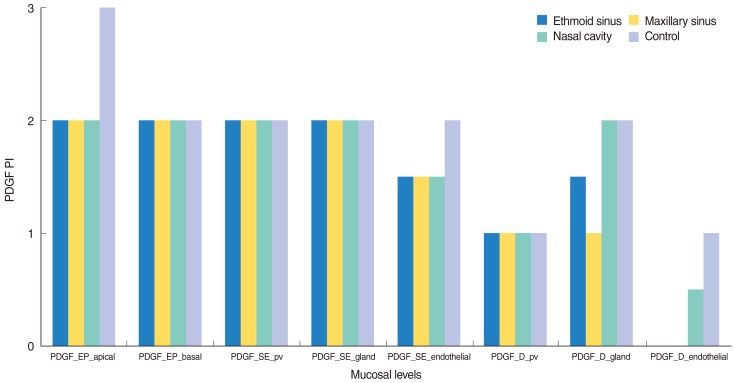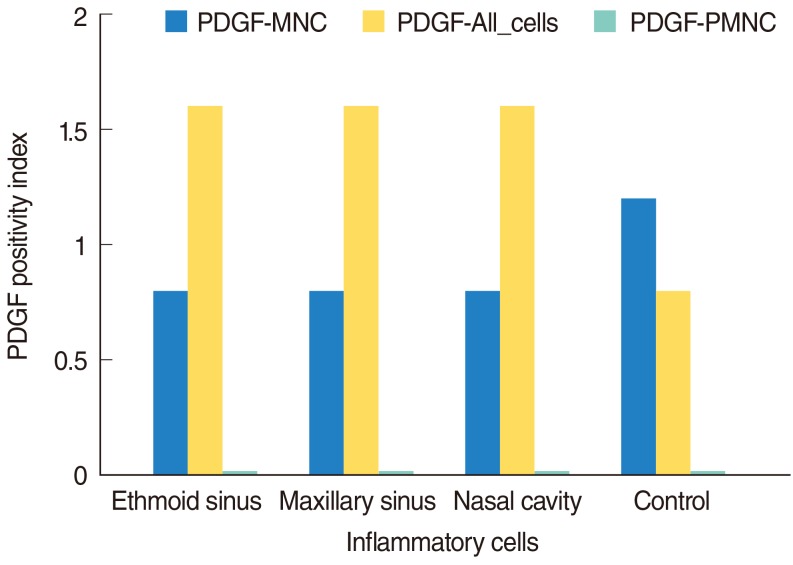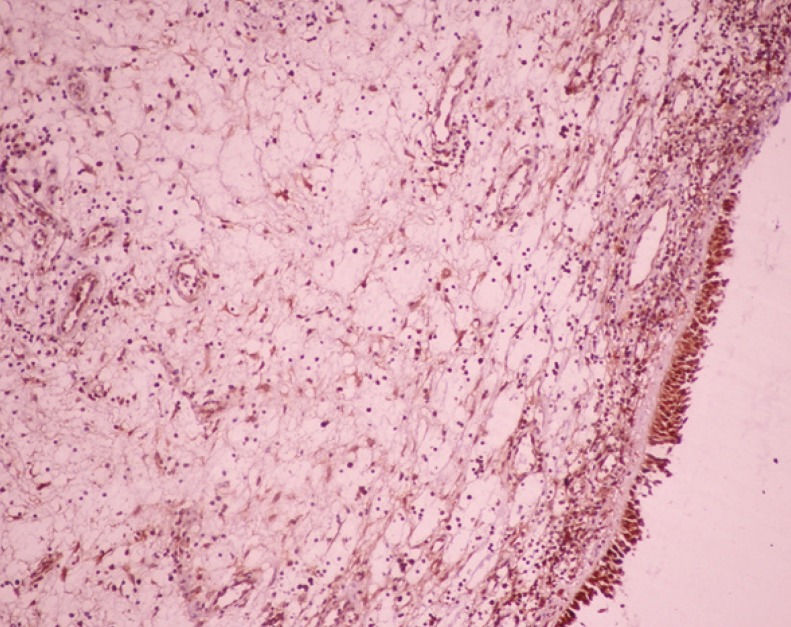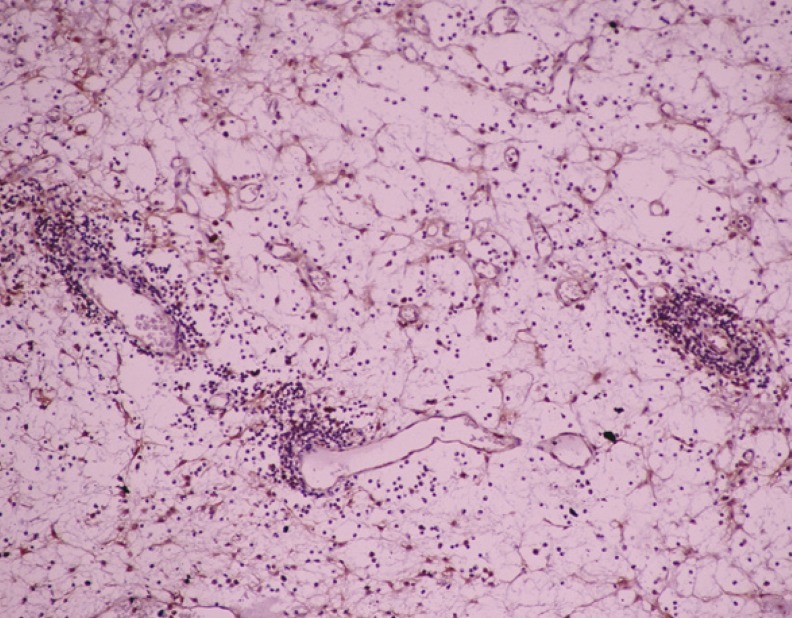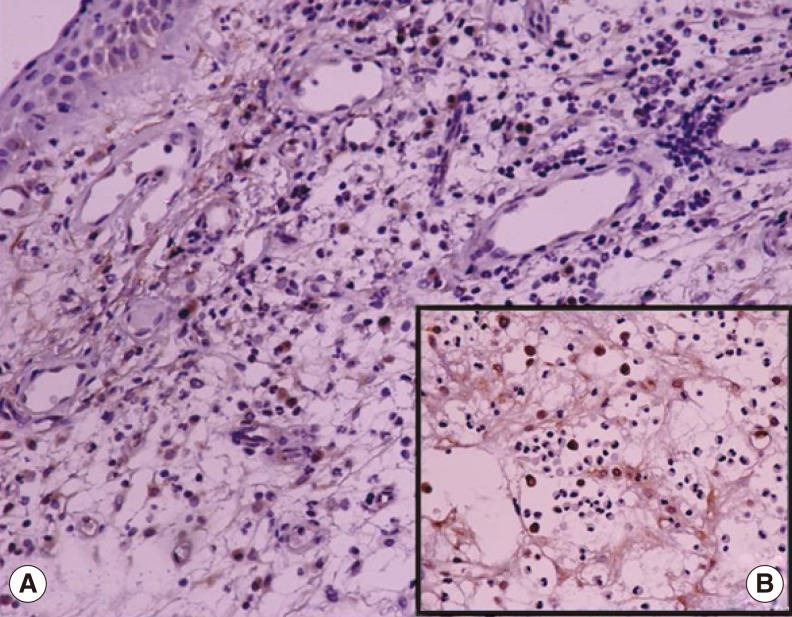Clin Exp Otorhinolaryngol.
2013 Sep;6(3):152-160.
The Role of Platelet-Derived Growth Factor in the Pathogenesis of Sinonasal Polyps: Immunohistochemical Assessment in Epithelial, Subepithelial and Deep Layers of the Mucosa
- Affiliations
-
- 1ENT Department, Kirikkale University Faculty of Medicine, Kirikkale, Turkey. nurayb@hotmail.com
- 2ENT Department, Adana Numune Education and Training Hospital, Adana, Turkey.
- 3Pathology Department, Kirikkale University Faculty of Medicine, Kirikkale, Turkey.
- 4ENT Department, Artvin State Hospital, Artvin, Turkey.
Abstract
OBJECTIVES
The aim of this study is to investigate the role of platelet-derived growth factor (PDGF) in the pathogenesis of sinonasal polyps.
METHODS
Study group (groups 1-3) consisted of nasal polyp samples of patients with sinonasal polyps and the control group consisted of inferior turbinate samples of patients without nasal polyp. In group 1, 14 specimens from ethmoid sinus; in group 2, 10 specimens from nasal cavity; in group 3, 10 specimens from maxillary sinus; and in group 4 (control), 9 specimens from inferior turbinate were included. By immunohistochemical staining technique, the PDGF positivity index (PI) in mucosal layers and in the inflammatory cells were assessed at the epithelium (EP), subepithelial layer of lamina propria (SE), and deep paraglandular layer of the mucosa (D).
RESULTS
Polymorphonuclear cell (PMNC)-percentage (%) values of ethmoid and maxillary sinus, and the PDGF PI from all cells of ethmoid sinus and nasal cavity were significantly higher than those of the control group. As mononuclear cell-% (MNC-%) increased, the PDGF_EP_basal PI, PDGF_SE_endothelial PI, and PDGF_D_endothelial PI decreased. As PMNC-PDGF PI increased, the PDGF_D_perivascular PI decreased and PDGF_D_endothelial PI increased. As PDGF-MNC PI increased, the PDGF_EP_apical PI, PDGF_SE_endothelial PI, and PDGF_D_endothelial PI decreased. As PDGF-all cells (PMNCs, MNCs, and fibroblasts) PI increased, the PDGF_EP_basal PI and PDGF_D_endothelial PI decreased, and the PDGF_D_perivascular PI increased.
CONCLUSION
We concluded that the PDGF systems play important roles in polyp pathogenesis. Fibroblast-derived PDGF may be more important than MNC-derived PDGF in polyp developing process. Increased perivascular-PDGF-PI in deep layers of the mucosa may result in sinonasal polyp formation by causing an increase in vascular permeability and extracellular edema, and thus promoting migration of inflammatory cells to extracellular area. Tissue oxygenization may be important for the initiation of PDGF release system. Because of this reason, nasal obstruction should be medically treated earlier, and, if necessary, by surgical approaches.
MeSH Terms
Figure
Reference
-
1. Cekin E, Ipcioglu OM, Erkul BE, Kapucu B, Ozcan O, Cincik H, et al. The association of oxidative stress and nasal polyposis. J Int Med Res. 2009; Mar-Apr. 37(2):325–330. PMID: 19383225.
Article2. Tos M, Mogensen C. Pathogenesis of nasal polyps. Rhinology. 1977; 6. 15(2):87–95. PMID: 918518.3. Drake-Lee AB. The pathogenesis of nasal polyps. In : Settipane GA, Lund VJ, Bernstein J, Tos M, editors. Nasal polyps: epidemiology pathogenesis and treatment. Rhode Island: Ocean Side Publications;1997. p. 17–64.4. Kouzaki H, Seno S, Fukui J, Owaki S, Shimizu T. Role of platelet-derived growth factor in airway remodeling in rhinosinusitis. Am J Rhinol Allergy. 2009; May-Jun. 23(3):273–280. PMID: 19490801.
Article5. Hoch RV, Soriano P. Roles of PDGF in animal development. Development. 2003; 10. 130(20):4769–4784. PMID: 12952899.
Article6. Driscoll PV, Naclerio RM, Baroody FM. CD4+ lymphocytes are increased in the sinus mucosa of children with chronic sinusitis. Arch Otolaryngol Head Neck Surg. 1996; 10. 122(10):1071–1076. PMID: 8859119.
Article7. Kume A, Kume T, Masuda K, Shibuya F, Yamazaki H. Dose-dependent effects of cigarette smoke on blood biomarkers in healthy Japanese volunteers: observations from smoking and non-smoking. J Health Sci. 2009; 55(2):259–264.
Article8. Lavigne F, Nguyen CT, Cameron L, Hamid Q, Renzi PM. Prognosis and prediction of response to surgery in allergic patients with chronic sinusitis. J Allergy Clin Immunol. 2000; 4. 105(4):746–751. PMID: 10756225.
Article9. Lawson W. The intranasal ethmoidectomy: an experience with 1,077 procedures. Laryngoscope. 1991; 4. 101(4 Pt 1):367–371. PMID: 1895851.
Article10. Can IH, Ceylan K, Caydere M, Samim EE, Ustun H, Karasoy DS. The expression of MMP-2, MMP-7, MMP-9, and TIMP-1 in chronic rhinosinusitis and nasal polyposis. Otolaryngol Head Neck Surg. 2008; 8. 139(2):211–215. PMID: 18656717.
Article11. World Medical Association Declaration of Helsinki: ethical principles for medical research involving human subjects. JAMA. 2000; 12. 284(23):3043–3045. PMID: 11122593.12. Mygind N, Dahl R, Bachert C. Nasal polyposis, eosinophil dominated inflammation, and allergy. Thorax. 2000; 10. 55 Suppl 2:S79–S83. PMID: 10992568.
Article13. Olofsson B, Pajusola K, Kaipainen A, von Euler G, Joukov V, Saksela O, et al. Vascular endothelial growth factor B, a novel growth factor for endothelial cells. Proc Natl Acad Sci U S A. 1996; 3. 93(6):2576–2581. PMID: 8637916.
Article14. Joukov V, Pajusola K, Kaipainen A, Chilov D, Lahtinen I, Kukk E, et al. A novel vascular endothelial growth factor, VEGF-C, is a ligand for the Flt4 (VEGFR-3) and KDR (VEGFR-2) receptor tyrosine kinases. EMBO J. 1996; 1. 15(2):290–298. PMID: 8617204.
Article15. Wikipedia. Platelet-derived growth factor [Internet]. Wikipedia;2012. cited 2012 Jan 5. Available from: http://en.wikipedia.org/wiki/Platelet-derived_growth_factor.16. Hannink M, Donoghue DJ. Structure and function of platelet-derived growth factor (PDGF) and related proteins. Biochim Biophys Acta. 1989; 7. 989(1):1–10. PMID: 2546599.
Article17. Heldin CH. Structural and functional studies on platelet-derived growth factor. EMBO J. 1992; 12. 11(12):4251–4259. PMID: 1425569.
Article18. PDGF pathways [Internet]. cited 2007 Nov 17. Available from: http://www.multi-targetedtherapy.com/pdgfSignaling.asp.19. Ohno I, Nitta Y, Yamauchi K, Hoshi H, Honma M, Woolley K, et al. Eosinophils as a potential source of platelet-derived growth factor B-chain (PDGF-B) in nasal polyposis and bronchial asthma. Am J Respir Cell Mol Biol. 1995; 12. 13(6):639–647. PMID: 7576701.
Article20. Levakov A, Vuckovic N, Dolai M, Kacanski MM, Bozanic S. Age-related skin changes. Med Pregl. 2012; May-Jun. 65(5-6):191–195. PMID: 22730701.
Article21. Zhou L, Dong J, Yu M, Yin H, She M. Age-dependent increase of NF-kappaB translocation and PDGF-B expression in aortic endothelial cells of hypercholesterolemic rats. Exp Gerontol. 2003; 10. 38(10):1161–1168. PMID: 14580869.22. Weibrich G, Kleis WK, Hafner G, Hitzler WE. Growth factor levels in platelet-rich plasma and correlations with donor age, sex, and platelet count. J Craniomaxillofac Surg. 2002; 4. 30(2):97–102. PMID: 12069512.
Article23. Kajizuka M, Miyachi T, Matsuzaki H, Iwata K, Shinmura C, Suzuki K, et al. Serum levels of platelet-derived growth factor BB homodimers are increased in male children with autism. Prog Neuropsychopharmacol Biol Psychiatry. 2010; 2. 34(1):154–158. PMID: 19879307.
Article24. Thuillier R, Mazer M, Manku G, Boisvert A, Wang Y, Culty M. Interdependence of platelet-derived growth factor and estrogen-signaling pathways in inducing neonatal rat testicular gonocytes proliferation. Biol Reprod. 2010; 5. 82(5):825–836. PMID: 20089883.25. Heldin CH, Westermark B. Mechanism of action and in vivo role of platelet-derived growth factor. Physiol Rev. 1999; 10. 79(4):1283–1316. PMID: 10508235.
Article
- Full Text Links
- Actions
-
Cited
- CITED
-
- Close
- Share
- Similar articles
-
- The Physiologic Roles of the Subepithelial Platelet-derived Growth Factor Receptor alpha-positive Cells in the Colon (Am J Physiol Gastrointest Liver Physiol 2013;304:G823-G834)
- Expression of Transforming Growth Factor-beta(TGF-beta) Family in Nasal Polyps and Postoperative Polypoid Mucosa after Functional Endoscopic Sinus Surgery
- Pathogenesis of Nasal Polyps
- Upregulation of Prostasin in Nasal Polyps
- Effects of Platelet-derived Growth Factor on the Activity of Osteoblastic Cells

